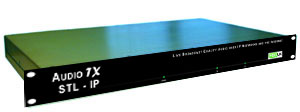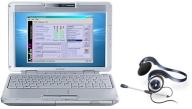STL-IP Connect for live broadcasts
over the Internet using DSL, WiFi hotspots, WiMAX, 3G mobile phone
data, Comrex Access Tieline IP codec reporter remote |
 |
| The
STL-IP Connect system is unique
- the pairing of a software solution in the field and a rackmount
unit in the studio is the perfect combination! |
|

|
| Compared
with other connection options |
| The
STL-IP Connect solution is designed to be used in two ways:
Internet:
Reporter/News and Remote broadcast (Outside Broadcast)
applications using Internet connections - including ADSL/DSL or
other high-speed internet, WiFi and other wireless public internet
access, mobile applications using Satellite and mobile phone data
connectivity.
Other
IP Networks: LAN, WAN, Private network connections, VPNs
etc.
The
availability of one or more of the above Internet or mobile data
connection options in so many of the locations from which you'd
want to broadcast makes STL-IP Connect a perfect solution - allowing
radio professionals to get on air anywhere and immediately with
their live broadcast.
Connection
options like ISDN have always been more inconvenient
- you're tied to a location that actually has an ISDN line. And,
nowadays, that's if you can actually find one - Telecomms companies
have already started to withdraw support for ISDN in many countries. |
| Why
did we choose a solution that combines software and hardware? |
An
interesting question. As we've explained on the other pages of this
site, STL-IP Connect works in the following way:
- In
the Field, you use the STL-IP Connect IP Codec software on your
Laptop or PC.
- At
the Studio you use the STL-IP rackmount unit.
We're
asked almost every day why we have not just made a portable version
of our STL-IP unit for field use - a hardware unit that ran on batteries
or mains. We thought about this for some time - bear in mind that
here at AudioTX we've been offering audio over IP solutions to broadcasters
for over 6 years... we're not new to this(!) - but the decision
was quite an easy one in the end.
Let's
provide the answer by using a few simple examples and using the
fictional example of a standalone portable IP
codec unit called the STL-IP-Away.
|
Example
1:
- You
plan to do a broadcast from Central Park in New York.
- You
arrive on the day, armed with your portable IP unit.
- There
are quite a few WiFi services that operate in this area and so
you'll have no problems getting a connection!
- So
you are sitting comfortably on a park bench with your guests,
microphone in hand, ready to start.
- Oh,
but hold on. Disaster has struck. Before you can use these WiFi
services, you have to log-in with a username and password. But
you can't do that with an STL-IP-Away can you? How irritating
that the WiFi provider expects you to log-in using a Laptop when
you don't want to use a Laptop... you want to use STL-IP-Away
which doesn't have a keyboard, a screen or a web browser to do
this with!
- End
of transmission. Before it even started.
Reason
1: Using a Laptop allows you to easily log-in to public internet
services and all network configuration is done automatically when
you log in. As soon as you can see a webpage on your computer you're
ready to start STL-IP Connect and start broadcasting.
Example
2:
- You
have just received a package containing your new 3G high speed
mobile data card.
- Excellent.
You plan to celebrate by doing your inaugural broadcast from a
bar round the corner.
- But,
hold on a minute - doesn't your shiny new card need to be plugged
into your laptop? How will you connect it to your STL-IP-Away?
- So
you call the manufacturer and ask them. They tell you that they
have a special card that they have designed for mobile data services.
But it's not the one you have and it's not compatible with your
mobile network. And it only works in your own country. When you
go to Europe next week, you'll need another card... which won't
be available until after Christmas. Oh.
- End
of transmission. Before it even started.
Reason
2: A standard mobile data card (and pretty much any other
method of wireless data which will ever be invented in future) will
most likely be something you can use on a Laptop with no problems
and so can immediately use with STL-IP Connect.
Example
3:
- Your
station has just done a promotional deal with Shazam Grocery Stores
inc. and your boss at the station tells you to do a live show
from the local store.
- Great,
you think, I'll use my new STL-IP-Away for this. You've checked
and they have DSL there. Surely there can't be a problem here...?
Oh yes there can... and don't call me Shirley.
- So
you show up and plug your STL-IP-Away into the DSL router. You
try and connect but nothing happens. It's probably because you
need to set up your IP address and gateway settings correctly
for the DSL router. But you don't know what settings to use.
- End
of transmission. Before it even started. How much was that sponsorship
deal worth again?
Reason
3: With a Laptop, whoever's network it is and however big
- from a DSL router in a store, to a big company network, all you
have to do is set your Laptop to use DHCP to get the network settings
automatically. You can then check that your internet access is working
- say by going to a website - and then you can get on-air.
Example
4:
- You're
heading for the local branch of Cash'r'Us Bank for a remote you've
organised - your news people are also coming as they want to ask
a spokesman few questions about a recent money laundering case.
- Easy
- you just plan to plug your new STL-IP-Away unit into their network
and get internet access that way - the bank has a really fast
internet connection - they're a big company.
- With
your STL-IP-Away portable hardware unit, you have a very difficult
time working out what network settings should be used.
- Then
you also have problems making sure that you have working Internet
access through their firewalls and routers.
- With
STL-IP Connect on your Laptop, you simply set your laptop to get
network settings via DHCP and then check you have internet access
(by visiting a web page).
- Even
if you still have a problem, an IT person at the company can easily
explain how you can get internet access from a Laptop - they know
how to do that even if they insist that they virus scan it first
- but are they interested in working out how you do it on a broadcast
codec they have never seen before and do not understand... and
will they even allow you to connect such a device to their business
network in any case?
Reason
4: Most IT people in any company who's network you'll use
can help you get your laptop working on their network and with Internet
access in five minutes. They may not be able or willing to do this
with a hardware unit they have never seen before. With the current
focus on network security they may even refuse to allow you to plug
a unit they have never seen before into their network. |
I
guess you'll be sending that fictional STL-IP-Away back to the manufacturer
for your fictional refund.
There
were a whole load of other scenarios we looked at with similar conclusions
- plus the obvious advantages of using a Laptop...
- they're
highly portable
- you're
probably carrying one anyway
- it
allows us to offer nice extras like the File Playback feature
where you can use pre-recorded clips of audio during a live connection
And,
most important of all, we wanted to be able to offer a system that
had the best quality and reliability, and didn't require you to
be an IT genius to use. Even if you are an IT genius, isn't your
focus supposed to be on that news report or remote? |
|

